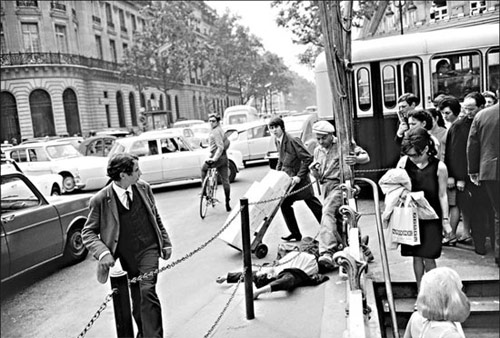A photographer's restless quest to pay attention
Updated: 2012-11-26 16:19
By Randy Kennedy (China Daily/Agencies)
|
|||||||||||
 |
|
Works by Joel Meyerowitz, "Fallen Man, Paris" (1967). Photographs Courtesy of Howard Greenberg Gallery / Phaidon |
 |
|
Works by Joel Meyerowitz, "Los Angeles Airport California" (1976. Photographs Courtesy of Howard Greenberg Gallery / Phaidon |
"I call it the Zen bell," the photographer Joel Meyerowitz said recently, describing a nagging compulsion to begin a long-term project about banks in the wake of the Great Recession. "I keep hearing it ringing," he added, "so I'm going to pay attention."
During a career that turns 50 this year Mr. Meyerowitz's work has often seemed to be the product of more than one person: Fifth Avenue in Manhattan, where he made himself into a well-known street photographer in the early 1960s; Cape Cod, where his pictures of sky and artificial light helped crash the use of color into the black-and-white art photography world; Europe, where his cinematically complex urban scenes influenced a younger generation of photographers; ground zero after the September 11 attacks.
The publication this month of "Taking My Time," a hefty two-volume retrospective, puts these bodies of work in one place for the first time. With scores of pictures never before published, it is likely to go a long way toward redefining the career of a groundbreaking artist who has had a tendency to fade into the background.
For those who recognize his name mostly because of "Cape Light," the 1979 book that pioneered the use of color, the new book and a related exhibition at the Howard Greenberg Gallery in New York will undoubtedly come as a surprise.

In many of his early street pictures, America is a deceptively vertiginous place, teetering on the edge of late-'60s convulsion.
A pale woman in a 1963 photo, her eyes clenched, holds a presciently paranoid sign: "Electronic parts as small as the head of a pin have been made. A camera could go through the hollow of a hollow needle. Soon, 'Big Brother' may be able to sit in front of his TV and see or hear."
In other pictures a boy levels a toy pistol at a baby in a carriage; Jacqueline Kennedy's head, on a television, hovers plaintively above a milling crowd; two toy train cars list to the side behind dilapidated houses on a barren Western landscape.
"There's nobody who was doing quite as dramatically as Meyerowitz that kind of guerrilla style of street photography that he carried from the '60s into the color work of the '70s and '80s," said Brian Wallis, the chief curator of the International Center of Photography in New York. "I've never understood why he's never quite gotten his due."
He said he sees Mr. Meyerowitz's influence in the work of socially keen-eyed photographers like Paul Graham and Alec Soth.
Rineke Dijkstra, known for her large-scale color portraiture, said Mr. Meyerowitz's work was a "real eye-opener" for her as a student in Amsterdam in the 1980s. Like many other young European photographers, she was working in black-and-white, but Mr. Meyerowitz's complex way with light helped her understand the power of color.
"There was this beautiful silence with no people," Ms. Dijkstra said of many of his best-known images. "But they also look like, in a way, he tried to compose reality somehow."
Mr. Meyerowitz, 74, said he has never seen himself as anything other than a member of the "honor-what-you-see, the frame-is-the-frame generation."

"The thought for us was always: 'How much could we absorb and embrace of a moment of existence that would disappear in an instant?'" he said, adding, "There was an almost moral dimension."
He quit his job at an advertising firm and taught himself to be a street photographer. "The one thing I knew at that time was that I needed to be on the street," he said. "I was really hooked on an Ashcan-School-like view of real life, of the messiness and the complexity of it."
Many art photographers at the time saw color as hopelessly commercial, but it was never much of a question for him: "The simple fact of the matter was that it just provided more information, and I wanted more information."
By the mid-1970s he had started taking what he called field photographs, in which he tried to look beyond a single locus of action and shoot from much farther back, to encompass more complex scenes. He said: "I wanted a picture that didn't say itself right away, that didn't give itself up. But that's always risky, because you work with this fear that in trying to get too much, maybe you're not getting anything."
For the last few years he has been making pictures to illustrate the classical elements of earth, fire, water and air.
"And let me tell you, a picture of dirt can be pretty damned dull," he said. "I ask myself: 'Is this insane? Is this another dead end or a way in?' I'm still trying to find out."
The New York Times
Related Stories
Visitors applaud photo display 2012-11-14 09:46
Instant avatars 2012-11-02 17:14
Autumn scenery of Wuzhuan 2012-10-30 17:10
Naked truth challenges values 2012-10-22 14:38
Eye in the sky 2012-10-18 10:12
Today's Top News
President Xi confident in recovery from quake
H7N9 update: 104 cases, 21 deaths
Telecom workers restore links
Coal mine blast kills 18 in Jilin
Intl scholarship puts China on the map
More bird flu patients discharged
Gold loses sheen, but still a safe bet
US 'turns blind eye to human rights'
Hot Topics
Lunar probe , China growth forecasts, Emission rules get tougher, China seen through 'colored lens', International board,
Editor's Picks

|

|

|

|

|

|





